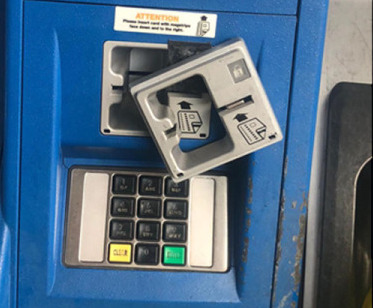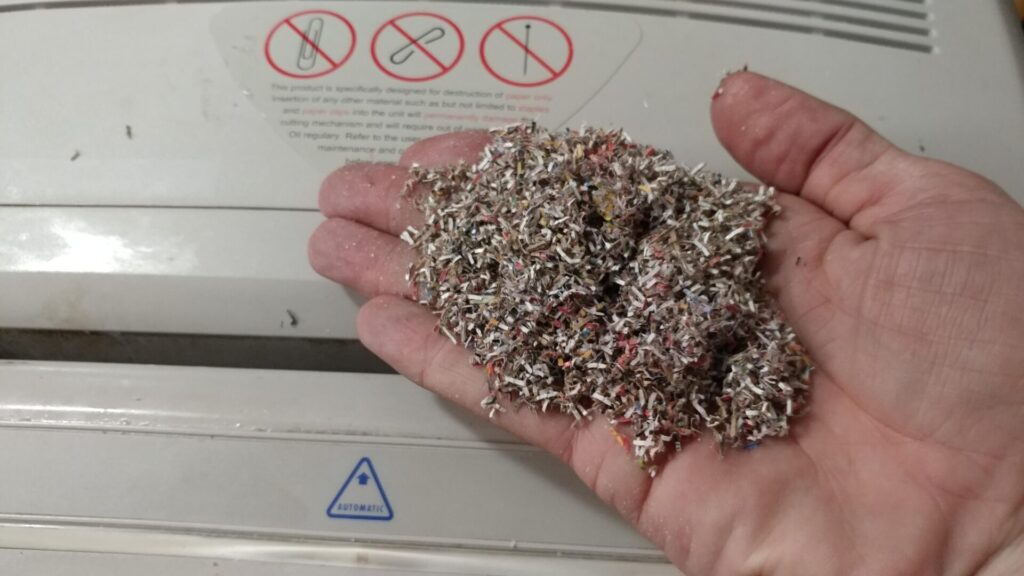Financial identity theft occurs when someone steals your personal and financial information, such as your name, address, Social Security number, credit card or bank account numbers, and uses it to make unauthorized purchases or to access your financial accounts without your permission.
The goal of financial identity theft is to gain access to your financial resources, steal your money or use your credit for their own purposes. This can damage your credit score and financial standing, and it can take a lot of time and effort to resolve the situation and recover your losses.

How Financial Identity Theft Happens
- Skimming: Thieves can use skimming devices at ATMs or gas pumps to steal your credit or debit card information.
- Phishing: Scammers can send emails or text messages that appear to be from your bank or other financial institutions, asking you to provide personal information such as your account number or password.
- Social engineering: Thieves can use social engineering tactics, such as impersonating someone in authority, to trick you into giving them your personal or financial information.
- Data breaches: Hackers can gain access to large databases of personal and financial information through data breaches at companies or organizations that store your data.
- Stealing mail: Thieves can steal mail from your mailbox or trash to obtain your financial information.
- Shoulder surfing: Thieves can look over your shoulder while you’re entering your PIN number or other financial information.
- Malware: Thieves can use malware to infect your computer or mobile device and steal your personal and financial information.
Phishing attacks are a common technique, where attackers send emails or messages that appear to be from legitimate institutions, asking for sensitive information. These messages often contain links to fake websites that mimic real ones, tricking victims into entering their personal details.
Another method is through the installation of malware on the victim’s computer or smartphone. This can be done through email attachments, malicious downloads, or compromised websites. Once installed, the malware can log keystrokes, capture screen information, and access files, thereby obtaining sensitive information without the user’s knowledge.
Social engineering tactics are also employed, where attackers use manipulation and deceit to gain trust and extract confidential information directly from the victim or through third-party services. This might involve pretexting, where the attacker pretends to need the victim’s personal information for verification purposes, or baiting, where they offer something enticing in exchange for information.
Skimming devices installed on ATMs or point-of-sale systems capture credit or debit card information when transactions are made. These devices can be hard to detect and can store card data from multiple victims before the information is retrieved by the attackers.

Data breaches at financial institutions, retailers, or service providers can expose vast amounts of personal and financial information. Hackers exploit vulnerabilities in the security systems of these organizations to access databases containing sensitive data.
Once attackers obtain this information, they can use it to impersonate the victim, accessing financial accounts, opening new lines of credit, or making unauthorized purchases. The complexity of these attacks and the variety of methods used make financial identity theft a persistent and evolving threat.
Signs of Financial Identity Theft
Here are some signs that you may be a victim of financial identity theft:
- Unexplained charges or withdrawals: You notice charges or withdrawals on your financial accounts that you didn’t make or authorize.
- Unexpected bills or collections notices: You receive bills or collections notices for services or products that you didn’t purchase.
- Denied credit or loan applications: You’re denied credit or a loan, even though you have a good credit score and financial history.
- Unknown accounts or inquiries: You see new accounts or inquiries on your credit report that you didn’t initiate.
- Missing mail: You stop receiving mail, such as bills or financial statements, that you normally receive.
- Poor credit score: Your credit score drops unexpectedly, even though you haven’t changed your credit habits.
Unexpected financial statements or bills for services and goods you did not purchase often signal financial identity theft. This can include accounts you did not open or charges on your credit card that you cannot account for. Similarly, receiving credit cards that you did not apply for is a red flag, indicating someone else may have applied for credit in your name.
Credit Card Fraud Accounts for 43.7% of Identity Theft.
Missing mail or email can suggest that an identity thief has changed your account contact information to divert billing statements and prevent you from noticing unauthorized charges. If you notice that expected bank statements or bills do not arrive, it’s worth investigating.
Denials of credit for no apparent reason can be alarming. If your credit application is unexpectedly rejected despite a previously good credit score, it might mean an identity thief has damaged your credit through fraudulent activities.
Errors on your credit reports, such as accounts you don’t recognize, incorrect personal information, or inquiries from companies you haven’t contacted, indicate potential financial identity theft. Regular monitoring of your credit report can help catch these discrepancies early.
Calls from debt collectors about debts that aren’t yours are a clear indication of financial identity theft. Such calls suggest that an identity thief may be using your personal information to obtain goods or services without paying.
Unexplained withdrawals from your bank account or unauthorized transfers can also point to identity theft. Monitoring your bank statements is crucial to quickly identifying and addressing any fraudulent transactions.
Each of these signs requires immediate attention and action to prevent further damage to your financial health and credit standing.
Financial Identity Theft Prevention
The following are some steps you can take to prevent financial identity theft:
- Monitor your accounts: Regularly check your bank and credit card accounts for any unauthorized transactions.
- Use strong passwords: Use unique, strong passwords for your financial accounts, and avoid using the same password across multiple accounts.
- Be careful with personal information: Don’t share personal information such as your Social Security number, date of birth, or bank account details with anyone unless you are sure of their identity and need for the information.
- Protect your mail: Make sure your mailbox is secure and collect your mail promptly. Consider using a locked mailbox or a post office box.
- Shred documents: Shred financial documents before throwing them away, including credit card offers and statements.
- Use secure websites: Only use secure, trusted websites when making online purchases or entering personal information.
- Be cautious of public Wi-Fi: Avoid using public Wi-Fi networks to access financial accounts or enter personal information.
- Check your credit report: Regularly check your credit report for any unusual activity or errors.
- Consider identity theft protection services: Consider using identity theft protection services that can monitor your credit and alert you to any suspicious activity.
Securing personal and financial information starts with the use of strong, unique passwords for each online account, incorporating a mix of letters, numbers, and symbols, and avoiding easily guessable information. Employing a reputable password manager can assist in generating and storing complex passwords securely. Enabling two-factor authentication (2FA) adds an additional layer of security, requiring not just a password and username but also something that only the user has on them, like a physical token or a text message code sent to their phone.
Regular monitoring of bank and credit card statements for unauthorized transactions is crucial. This allows for early detection of any fraudulent activity, enabling swift action to limit damage. Checking credit reports at least annually helps identify any discrepancies or unfamiliar accounts that may indicate identity theft.
The Median Loss to Financial Identity Theft Victims is $500.
Installing and regularly updating antivirus and anti-malware software on personal devices provides a robust defense against malicious software designed to steal personal information. Utilizing a secure, encrypted connection, especially on public Wi-Fi networks, can prevent eavesdropping and interception of data. A virtual private network (VPN) is recommended for enhancing online privacy and security.
Being cautious with personal information online involves not sharing sensitive details on social media or other public platforms and being wary of phishing scams that solicit personal information through emails or messages that appear to be from legitimate institutions.
Shredding documents containing personal or financial information before disposal can prevent thieves from piecing together information from trash or recycling bins. This includes bank statements, credit card offers, and other documents that may contain sensitive data.

Securing physical documents and cards in a safe place, especially when traveling, minimizes the risk of them being stolen or lost. It’s also important to only carry essential documents; for instance, leaving the Social Security card at home unless absolutely necessary.
Reporting lost or stolen cards immediately to the issuing institution helps prevent unauthorized use. Financial institutions can then take swift action, such as freezing or closing accounts, to protect against fraudulent transactions.
What Should You Do if You Suspect Financial Identity Theft
If you suspect financial identity theft, it’s important to take immediate action to minimize the damage and protect your financial accounts. Here are the steps you should take:
- Contact your financial institutions: Call your bank and credit card companies and report the suspicious activity. Ask them to freeze or close any accounts that have been compromised.
- File a report with the authorities: Contact your local law enforcement agency and file a report. This can help with any legal action and can also help you get any fraudulent accounts or charges removed from your credit report.
- Check your credit report: Request a free copy of your credit report from each of the three major credit reporting agencies (Equifax, Experian, and TransUnion) and check for any unauthorized accounts or inquiries.
- Place a fraud alert: Consider placing a fraud alert on your credit report to alert lenders to verify your identity before issuing credit.
- Monitor your accounts: Regularly monitor your bank and credit card accounts for any further unauthorized activity.
- Update your passwords: Change the passwords for all of your financial accounts and make sure you use strong, unique passwords for each one.
Immediately contact your bank and credit card issuers to report suspected fraud. This step is crucial for preventing further unauthorized transactions and starting the process of disputing charges. Requesting a freeze on your credit reports with the three major credit bureaus—Equifax, Experian, and TransUnion—can stop identity thieves from opening new accounts in your name. This freeze can be lifted by you when you need to apply for credit.
Filing a report with the Federal Trade Commission (FTC) through their website or by phone provides an official record of the identity theft and gives you a recovery plan. The FTC’s report can also serve as evidence when dealing with creditors.
Report Financial Identity Theft
Report Your Financial ID Theft to the FTC at IdentityTheft.gov
Filing a police report with your local law enforcement is important, especially if you have evidence of who the identity thief might be or if the theft has led to significant financial loss.
Changing passwords, PINs, and any security questions for your financial accounts and other online accounts is a necessary step to regain security control. Ensuring that each account has a unique, strong password helps prevent further unauthorized access.
Reviewing your credit reports for discrepancies allows you to identify any fraudulent activity or accounts you didn’t open. Disputing errors with the credit bureaus directly is essential for correcting your credit record.
Notifying other affected parties depending on the nature of the identity theft is also necessary. This may include your employer, insurance companies, and medical providers if the theft involves employment, insurance fraud, or medical identity theft.
Monitoring your accounts and credit reports closely after the theft helps you catch any new instances of fraud early. Consider subscribing to a credit monitoring service for ongoing vigilance.
2025 Data Sources
- https://consumer.ftc.gov/articles/what-know-about-identity-theft
- https://www.fdic.gov/consumers/consumer/
moneysmart/podcast/documents/
basics-of-banking-identify-theft.pdf - https://www.usbank.com/financialiq/manage-your-household/protect-your-assets/identity-stolen-5-steps-to-take-immediately.html
- https://www.wellsfargo.com/privacy-security/fraud/report/identity-theft/
- https://www.bankofamerica.com/security-center/identity-theft-protection/
- https://www.chase.com/content/dam/chase-ux/documents/digital/resources/identity-theft-kit.pdf